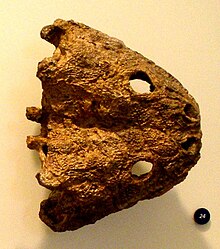| Brachyopoidea Temporal range: Early Triassic - Early Cretaceous, | |
|---|---|
 | |
| Skull of the brachyopoid Pelorocephalus mendozensis | |
| Scientific classification | |
| Domain: | Eukaryota |
| Kingdom: | Animalia |
| Phylum: | Chordata |
| Order: | † Temnospondyli |
| Suborder: | † Stereospondyli |
| Clade: | † Brachyopomorpha |
| Superfamily: | † Brachyopoidea Lydekker, 1885 |
| Families | |
Brachyopoidea is a superfamily of temnospondyls that lived during the Mesozoic. It contains the families Brachyopidae and Chigutisauridae. The earliest records of brachyopids are from the Lower Triassic in Australia. [1] The latest-surviving member of the superfamily is the chigutisaurid Koolasuchus from the Early Cretaceous of Australia.


